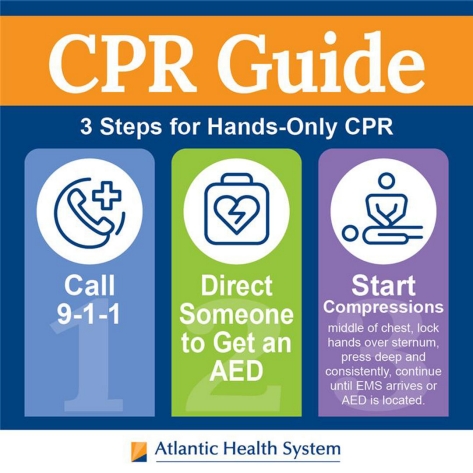
When someone is in cardiac arrest, cardiopulmonary resuscitation (CPR) can save their life. But only 18% of Americans have a current CPR certification. To help boost these numbers, John-Paul Couce, a paramedic and CPR education coordinator at Atlantic Health System shares 10 common misperceptions about this lifesaving technique.
1. It requires mouth-to-mouth resuscitation. FALSE.
The American Heart Association (AHA) says that continuous chest compressions without mouth-to-mouth ventilation is effective until professional medical services arrive. Chest compressions help to pump the heart and drive oxygen to the lungs, all at one time.
2. Performing CPR is complicated. FALSE.
There are only three steps needed for hands-only CPR. First, call 911. Second, direct someone to find an AED (defibrillator). Third, start chest compressions — lock your hands together in the middle of the person’s chest and sternum. Push hard and fast until support arrives.
3. Most CPR incidents happen in public. FALSE.
According to the AHA, more than 300,000 Americans experience non-hospital cardiac arrests each year, with 88% of them taking place at home. Proper CPR administered immediately at home increases survival rates.
4. Bystanders are often willing to perform CPR. FALSE.
Only a fraction of bystanders will perform CPR on a stranger. Maybe they don’t recognize the signs. Maybe they think mouth-to-mouth contact is required. Maybe they worry about a lawsuit. Regardless, the Good Samaritan law protects anyone attempting CPR to save a life.
5. Only adults with a current certification can perform CPR. FALSE.
Children ages 16 and older can get CPR-certified. Children as young as eight years old have successfully performed CPR. If anyone calls 911, the dispatcher will instruct CPR — step by step — and stay on the phone until help arrives.

6. CPR certification lasts a lifetime. FALSE.
Every five years the AHA updates their guidelines and procedures. A typical certification class usually lasts two years. This is because CPR is rarely used, and skills are quickly forgotten. Refresher courses are encouraged and available.
7. Women in cardiac arrest are as likely as men to receive CPR. FALSE.
Women’s symptoms are different than men’s and aren’t often perceived as heart problems. Weakness, fainting, an upset stomach or even a toothache are all female warning signs. They’re different from men’s chest pain that radiates down the arm, nausea, sweating and numbness.
8. CPR is only used for heart attacks. FALSE.
There are many medical conditions that can lead to cardiac arrest. Beyond stroke and heart conditions, CPR can save the life of someone who is choking, suffocating, drowning or overdosing on drugs.
9. It’s best to wait for emergency medical services to arrive. FALSE.
The national ambulance response time averages about eight minutes and varies greatly. After three minutes without oxygen, brain tissue begins to die and never regenerates. When someone can recognize the signs of cardiac arrest and start chest compressions, they buy time to prevent brain damage.
10. Most people who go into cardiac arrest will go on to live a quality life. FALSE.
Cardiac arrest survival rates depend on many circumstances. But even when CPR is performed, there is only a 10% chance of the pulse returning. Of that 10%, less than half will live life with negligible impact. The key is to quickly recognize symptoms and start chest compressions to give someone a fighting chance.
Be Proactive About Your Health
If a person is experiencing cardiac arrest, immediate cardiopulmonary resuscitation (CPR) offers a chance for survival.